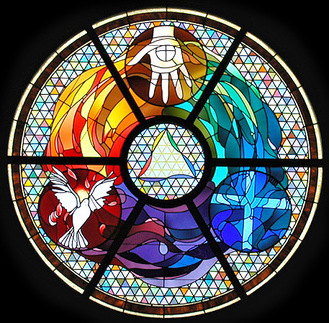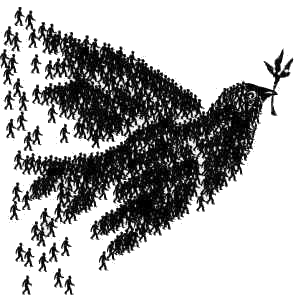
Today is Trinity Sunday, and like with the children, I like to start with a slightly offensive joke since jokes are good as any way to get at this daunting topic:
The Trinity were planning a holiday. The Spirit, manifesting the creative part of the divine nature, was coming up with the ideas. "Let's go to New York," he suggested. "No, no, no," said the Father, "They're all so liberated, they'll spend the whole time calling me 'Mother' and it will just do my head in."
So the Spirit sat back and thought. "I know, what about Jerusalem?" he said. "It's beautiful and then there's the history and everything."
"No way!" the Son declared. "After what happened the last time, I'm never going there again!" At this point, the Spirit got annoyed and went off in a huff. Sometime later he returned and found that the Father and Son had had an idea they both thought was excellent:
"Why don't we do a tour of church headquarters? We could go to Rome for the Catholics, Canterbury, England for the Anglicans; Constantinople for the Orthodox, Nashville to see the Southern Baptists and Louisville, Kentucky to visit the Presbyterians?" said the Son. "Perfect!" cried the Holy Spirit. "I've never been there before!"
Trinity Sunday is the only Sunday where a doctrine of the church, the belief in the triune God, is raised up to be celebrated. We celebrate major events like Christmas, Easter and Pentecost and special seasons like Lent and Advent. We celebrate the saints triumphant on All Saints Day and the body of Christ on World Communion Sunday, and specific events in Jesus’ life like his baptism, transfiguration and Second Coming of Christ on Christ the King Sunday. Today the church has seen fit to have us wrestle with the doctrine of the Trinity. Not specific ideas of God as Creator, God as Love, or merciful Judge --- although we do frequently speak of God as Father, Redeemer, and Holy Spirit throughout our ordinary worship. Today we focus exclusively on the Triune God – God, Three-in-One; One-in-Three.
After years of observing this wonderful feast day, Trinity Sunday, I appreciate the challenge, but sometimes wonder about its wisdom or reason. Author Madeleine L’Engle talks about the danger of a creative enterprise is like trying to pull all the petals off a flower in order to analyze it, only ending up having destroyed the flower. I highly doubt we will do much damage to the Trinity by our poking and prodding; even if we don’t get far, except for perhaps banging our heads against the wall.
There is always something lost in the translation when we try to pull the petals off. We are a monotheistic religion that believes in a triune God, whereas other monotheistic religions look at us askance, and wonder how we think we get away with it. Yet our earliest creeds, the Apostles Creed and the Nicene Creed describe God the Father Almighty, Jesus God of God, light of Light true God from True God, of one Being with the Father...and the Holy Spirt the Lord and Giver of Life who proceeds from the Father and the Son and with the Father and the Son is to be worshipped and glorified. The earliest believers thought and fought long and hard on the subject and these words, and it forms the backbone of our faith.
Some of the early church theologians thought it out this way. “The number 1 as no number at all because it had no diversity. It possessed no discernable strength. The number 2 was weak as well in that it was only a dualism. At best, it could only be two sides of the same coin. The number 3, then, was considered the first real 'number' in that it had an innate stability, a complexity; diversity, if you will, which made it durable and strong." What better number to contain the mystery and complexity of belief in God? The symbol of diversity and community, present within the Godhead itself, gives form and shape to human life and all creation. The Trinity is the most ancient archetype, a blueprint, the DNA for human life.
So how do we get at Trinity? Saint Patrick is said to have explained the Trinity to the Celts by using a shamrock, three individual leaves, yet still one plant. Augustine said the Trinity was best understood as the Lover, the Beloved, and the love which exists between them. Tertullian, another giant of the Early Church, used the metaphor of The Trinity as a plant, with the Father as the deep root, the Son as the shoot that breaks forth into the world, and the Spirit as the force which spreads beauty and fragrance on the earth.
In our day, radical feminists recall the images of maiden, mother and crone. Brazilian liberation theologian Leonardo Buff describes Trinity it as a primal community; "just and equal within the reality that is God...and, therefore, a model for human society." So the Trinity models communal life to which we are called; a life together marked by justice and peace, creativity, a place for all marked by equality and held together by love. To an extreme end, some youth pastors have even referred to the example of the “Three in one” shampoo.
The examples go on. Others have tried to capture nuances of the trinity in the natural world. Some say our own human beings, composed of body, mind and spirit, reflect a Trinity of sorts. Others look to the world of atoms and their basic particles of protons, electrons and neutrons. Some say it is fire that needs heat, fuel and oxygen to exist. Or Water, that can take the shape of ice, steam or liquid. Others point to light, that three primary colors blue, red and green produce a white light. Writer Dorothy Sayers says the creative process is Trinitarian: the creative idea, the creative energy and then creative power. The world is alive with Trinitarian imagery.
We could go on with examples or refute the examples already given. We come to the same conclusion. Our attempts to capture Trinity always elude us. Trinity is the ultimate kaon, a riddle to forever set our hearts and minds to churning, without ever being captured or understood. Perhaps this is one reason for the Trinity. To pull us in, engage us, without ever being fully comprehended. To ignite our longing, and point us to that something more. Perhaps this is why no matter how close we get, how wonderful an example we conjure up, we will always fall short. We cannot comprehend God, especially a Triune God. We can barely comprehend ourselves, let alone someone we love. We can only enter the part of the mystery that is ours to behold. We can only love God, and in those loving experiences truths that we could not access otherwise become evident to our hearts.
Jesus told the disciples the night before he died “I still have many things to say to you, but you cannot bear them now. But when the Spirit of Truth comes, he will guide you into all the truth.” This means that God always has something to say to us, and is always working to mold us into loving and just beings. It is God who is in charge of revelation, the bringer of grace, who understands us and prompt us in every day and age how to live as the body of Christ. Our understanding of civil rights, women and marriage equality have only come from the ongoing revelation of the Holy Spirit, acting on the justice of Jesus and the creative power of the Father: the source of love and life that is Trinity. We are reminded we don’t know everything. God has something new to say to us every moment of our lives – even if it is “I love you,” “I believe in you,” “I cherish you.” “Behold, I am doing a new thing.” This is good news, as the church faces an apparent decline in membership and interest, as the world faces terrorism and unbridled greed, we face uncertainties in our own lives; God has something to say.
It is the Triune God, source of creative energy, vision and love that will guide us, and bring us something new to say. The God always beyond us, never in our grasp, yet as close to us as our breath is with us. The Triune God – perfect community of love– seeks communion with us. So with faith and courage we can be open to new ways and new visions, because of our dynamic, Three-in-One God who loves us and is always there for us. It is a mystery, a riddle yes, but ultimately we are called to respond: in deed but in worship and praise, as we recall the words of St. Patrick:
I bind unto myself today
The strong name of the Trinity,
By invocation of the same,
The Three in One and One in Three.
With faith, hope and love, we bind ourselves to the strong name of the Trinity. Amen, Amen, Amen!
http://day1.org/4759-what_kind_of_math_is_this


 RSS Feed
RSS Feed